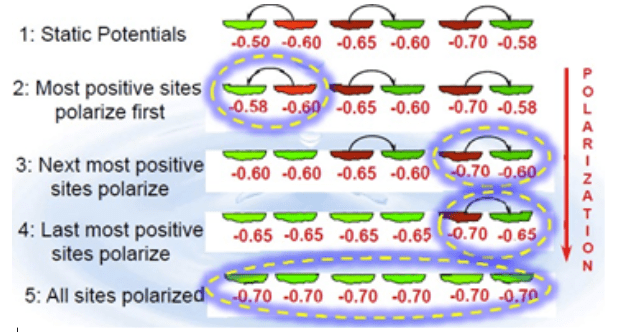Principles of Cathodic Protection on Buried Pipelines
By David Willoughby
Understanding Corrosion in Buried Metallic Pipelines
Buried metallic pipelines are subject to corrosion. This type of corrosion is an electrochemical reaction between the anodic and cathodic sites on the pipeline. This corrosion involves the flow of direct current (DC) through the soil or water from the anode to the cathode on the pipeline surface.
Electrochemical Reactions in Pipeline Corrosion
This current is generated by the potential or voltage difference between the anode and cathode on the pipeline surface. For buried pipeline corrosion to occur, there must be four elements: electrolyte, anode, cathode and a return circuit.
The Role of Electrolytes in Corrosion Processes
The electrolyte is the moisture in the soil capable of carrying an electric current. What occurs is basically this. At the anode, metal particles (positively charged ions) dissolve into the electrolyte. This leaves electrons behind on the surface of the anode. The electrons flow to the cathode through the return circuit. Now the electrolyte must remain electrically neutral. Therefore, since positive ions have been added to the electrolyte at the anode, some other positive ions must be displaced. Current flows through the electrolyte from the anode to the cathode. It returns to the anode through the return circuit. Corrosion occurs wherever current leaves the metal and enters the soil (electrolyte). The point where the current leaves is called the anode. Corrosion, therefore, occurs at the anode. Current is picked up at the cathode. No corrosion occurs here. The cathode is protected against corrosion. This is the basis of cathodic protection.
The Basics of Cathodic Protection (CP) for Corrosion Mitigation
Cathodic protection (CP) is one of the few methods that successfully mitigates corrosion. CP is often treated as a somewhat mysterious practice by those not familiar with this method of corrosion control. Many feel that CP is a complicated procedure when the basic concept of CP is simple. As previously mentioned, corrosion occurs where DC current discharges from the pipeline to the electrolyte at the anode. The objective of CP is to allow the entire pipeline to be cathodic. As the potential of the cathode sites polarize towards the potential of the anode sites, corrosion is reduced. When the potential of all cathode sites reaches the open circuit potential of the most active anode site, corrosion is eliminated.

Key Factors Influencing Cathodic Protection Effectiveness
The amount of current to be discharged from any single CP installation will depend largely on the amount of exposed metal on the pipeline (or portion of a pipeline) to be protected by that installation.
Determining the Current Requirements for CP Systems
To be technically feasible, CP requires that the protected pipeline be electrically continuous and immersed in an electrolyte to allow the distribution of current onto the pipeline. Electrical continuity of the pipeline may be through metallic continuity provided by bolting, welding, or bonding of the pipeline. The electrolyte is commonly water, or the water contained in moist earth. The resistivity of the electrolyte is an important factor in the determination of the need for CP and in the design of CP systems.
Types of Anodes Used in Cathodic Protection Systems
CP requires electrical current at the proper voltage or potential to prevent attack on the pipeline. These sources of current are commonly called “anodes.” Anodes may be fabricated from an active metal such as magnesium, or zinc which provides a potential source of electrons through self-corrosion. Anodes may also be fabricated from a relatively inert material which can pass current from its surface without being consumed at a high rate. This type of anode requires the use of an external energy source to increase the potential of the electrons supplied to the pipeline being protected. Anodes made from active metal are commonly called “sacrificial” or “galvanic” anodes, as the anode material is sacrificed to protect the pipeline under protection. The inert anodes are commonly called “impressed current” anodes as the external energy source is used to impress a current onto the pipeline under protection. The anodes must be electrically connected to the pipeline through a metallic connection to complete the circuit of the electrochemical cell responsible for the protection of the pipeline.
Comparing Sacrificial Anode and Impressed Current Systems
 CP using the sacrificial anode system is essentially a controlled electrochemical cell. Corrosion on the protected pipeline is shifted to the anode. The anode is consumed in the process but is designed and installed so that it is easily replaced when consumed. An anode life of 15 to 20 years is common. Anode life is dependent upon the amount of current discharged by the anodes and their size.
CP using the sacrificial anode system is essentially a controlled electrochemical cell. Corrosion on the protected pipeline is shifted to the anode. The anode is consumed in the process but is designed and installed so that it is easily replaced when consumed. An anode life of 15 to 20 years is common. Anode life is dependent upon the amount of current discharged by the anodes and their size.
The Importance of Electrical Continuity in CP Systems
From the standpoint of the pipeline being protected, CP using the impressed current method is essentially the same as in the sacrificial anode system. The CP system supplies high energy electrons to the pipeline being protected and the circuit of the electrochemical cell is completed through the soil. However, in the impressed current system, a supply of direct electrical current is used to develop the potential difference between the anode and the pipeline being protected. Consumption of the anode is not the driving force for the flow-protective current. A properly designed, installed, and maintained impressed current CP system is as effective as the galvanic anode type of system in preventing corrosion of the pipeline being protected.
More on Cathodic Protection
For more information regarding this blog topic, read our AC Corrosion on Buried Pipelines blog or join me in our training on Cathodic Protection for Buried Pipelines. You can also contact me, the author, David Willoughby, at [email protected]
Suggested Post
Why API Inspections Still Matter More Than Ever
Why API Inspections Still Matter More Than Ever By Kesley Price In an industry [...]
How Utility Teams are Standardizing Pipeline Calcs
How Utility Teams are Standardizing Pipeline Calcs By Kesley Price Engineering teams working in [...]
GASCalc and GASWorkS are Now Part of Technical Toolboxes
GASCalc and GASWorkS are Now Part of Technical Toolboxes We are pleased to announce that Technical Toolboxes has acquired the [...]











